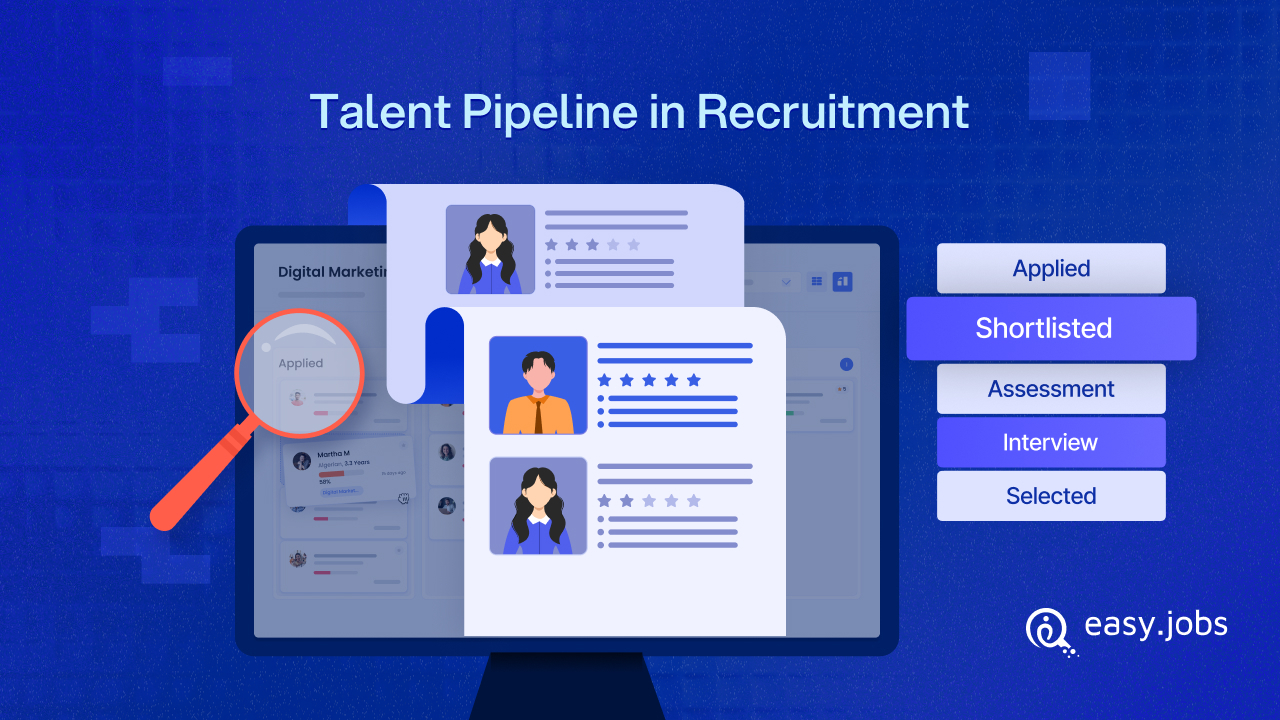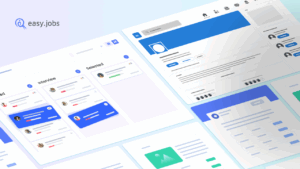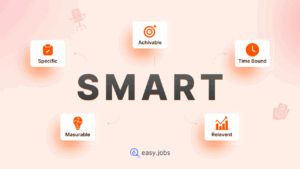Every successful business depends on people. The right talent can drive growth, inspire innovation and keep operations running smoothly. Without skilled and motivated employees, even the best business plan will fail. This is why attracting and keeping the right talent is one of the most important goals for any company today.

In a fast-changing job market, you cannot rely only on filling positions when they become vacant. This reactive approach can lead to rushed hiring decisions, higher costs and poor employee fit. The better way is to prepare in advance through Talent Pipeline Management. This is the process of building and maintaining a pool of qualified candidates who are ready to step into roles when needed. It allows you to hire faster, reduce risks and keep your business strong even during periods of change.
A resilient talent pipeline is more than just a list of names. It is a living system that you update, engage and align with your long-term goals. In this blog, you will learn proven methods to create and maintain such a pipeline. We will look at strategies, frameworks, and practical tools that make it easier to attract top talent and keep them interested. By the end, you will have a clear path to building a strong talent pipeline that supports lasting recruitment success.
Understanding Talent Pipeline Management

Talent Pipeline Management is a way for businesses to prepare for hiring needs before they actually arise. In simple terms, it means building and keeping a group of skilled candidates who could fit into your company in the future. Instead of waiting until a job opens and then rushing to find someone, you already have people in mind who are ready and interested.
This is different from reactive hiring, where you only start looking for talent after a position becomes vacant. Reactive hiring often leads to delays, higher recruitment costs and a greater risk of hiring the wrong person. With Talent Pipeline Management, you take a proactive approach. You plan ahead, identify the skills your company will need, and start building relationships with potential hires early.
A Talent Pipeline Framework provides a structured process for this. It usually includes steps like identifying talent sources, evaluating candidate skills, keeping regular contact and updating your pool as business needs change. This framework ensures that you are not just collecting names, but actively developing and maintaining a network of people who could join your team.
The benefits of pipeline-based recruitment are proven. Research from LinkedIn shows that companies with a strong talent pipeline can fill positions 42% faster than those without one. Another industry report found that proactive talent sourcing can reduce hiring costs by up to 23%.
In competitive industries, where top candidates are in high demand, having a talent pipeline can be the difference between securing the best people and losing them to a competitor. It is a smart, long-term investment in your company’s future workforce.
The Role of a Strong Talent Pipeline in Recruitment Success
A Strong Talent Pipeline is more than just a list of potential candidates. It is a carefully built pool of people who are already qualified, interested and aligned with your company’s needs. This kind of pipeline plays a big role in making recruitment faster, cheaper and more effective.
When you have pre-qualified candidates ready, you avoid the long delays that happen when you start a search from scratch. You can move quickly to fill a role because you already know who has the right skills and experience. This speed can also save money, as shorter hiring times often mean lower recruitment costs.
A strong talent pipeline also improves the chances of hiring people who will stay longer. Since you have taken time to get to know candidates in advance, you can judge whether they will fit well with your company culture and values. This helps reduce turnover and builds a more stable workforce.
In times of rapid growth or sudden employee departures, a talent pipeline becomes a safety net. You can maintain business continuity without the stress of rushed hiring decisions. Whether you are expanding into new markets, launching a new product, or replacing key team members, your pipeline gives you access to the right talent at the right time.
In short, a strong talent pipeline is not just a hiring tool. It is a long-term strategy that supports your company’s growth and stability.
Core Elements of an Effective Talent Pipeline Strategy
A Talent Pipeline Strategy is a long-term, proactive plan for finding, developing and keeping the right talent for your business. Instead of reacting when a job opens, this strategy helps you prepare in advance so you can hire quickly and confidently when the need arises. It is about being ready, not just for today’s roles, but for future positions as well.
There are four key pillars that make a talent pipeline strategy effective:
1. Candidate Sourcing
This is about finding the right people. You can use job boards, employee referrals, career fairs and professional networking platforms. Some companies also partner with universities or industry groups to connect with fresh talent early.
2. Candidate Nurturing
Not all great candidates are ready to change jobs right away. Nurturing means keeping in touch with them over time, sharing company updates and showing genuine interest in their career growth. This keeps your company top of mind when they are ready to move.
3. Assessment And Engagement
It is important to check in regularly to ensure a candidate’s skills and career goals still match your needs. This can be done through informal conversations, skills assessments, or project-based trials.
4. Diversity And Inclusion
Building a wide and varied talent pool ensures your company benefits from different perspectives and experiences. It also helps you attract talent from underrepresented groups.
A Talent Pipeline Framework ties these pillars together into a clear, repeatable process. For example, Google invests heavily in early talent programs and keeps strong relationships with interns, many of whom later become full-time employees. Another example is IBM, which uses ongoing engagement campaigns to maintain contact with past applicants and keep them interested in future opportunities.
When these elements work together, you create a system that keeps your pipeline active, diverse and ready to meet both planned and unexpected hiring needs. This is how companies stay competitive in fast-moving industries.
Talent Pipeline Development: From Concept to Execution
Talent Pipeline Development is the active process of finding, preparing and keeping potential candidates ready for future roles in your company. It is not just about identifying people who might be a good fit, but also about helping them grow so they are fully prepared when the opportunity comes.
Here are the key steps to develop a strong pipeline:
- Mapping Future Talent Needs
Start by looking at your company’s growth plans and upcoming projects. Decide which roles you will need to fill and what skills will be most important. This helps you focus your search in the right areas. - Identifying Skill Gaps
Compare the skills you already have in your team with the skills you will need in the future. Any gaps should guide your recruitment and training efforts. - Building Partnerships
Work with universities, training programs, or industry associations to connect with fresh talent. These partnerships give you access to candidates early, sometimes before they enter the job market. - Leveraging Technology
Use modern tools to make pipeline management easier. For example, easy.jobs offers a candidate pipeline feature that lets you organize candidates in different stages and track their progress. Its smart workflow helps automate repetitive tasks like screening and communication, saving time while keeping candidates engaged.
To keep your pipeline relevant, you must update it regularly. Here are some tips:
- Review your candidate list every few months and remove outdated contacts.
- Stay in touch with potential hires through emails, events, or social media.
- Encourage candidates to share updates about their skills or achievements.
- Adjust your search focus as your business goals change.
When you actively develop and maintain your talent pipeline, you are always ready to respond to hiring needs quickly. This approach not only saves time but also ensures you have a steady flow of qualified, motivated candidates who already understand and value your company.
How to Build A Talent Pipeline for Long-Term Success
To build a talent pipeline that supports long-term success, you need a clear plan and consistent effort. A good pipeline is not built overnight. It grows over time as you identify, connect with, and maintain relationships with the right people. Here is a step-by-step guide you can follow:
Step 1: Define Roles And Skill Requirements in Advance
Look at your company’s future needs and list the roles you expect to hire. For each role, write down the skills, experience and qualities that are most important.
Step 2: Create a Content And Outreach Plan
Share useful content that shows your company’s culture and values. This can be blog posts, videos, or success stories. Use social media, email and events to reach potential candidates and keep them engaged.
Step 3: Use Data Analytics to Track Pipeline Health
Monitor how many candidates are in your pipeline, how active they are and how quickly they move into open positions. This helps you spot gaps early and make improvements.
Step 4: Maintain Regular Communication
Stay in touch with candidates even when you do not have an immediate opening. Send updates about your company, invite them to events, or check in to see how they are doing.
Mini Checklist for Recruiters
✅ Roles and skills mapped out
✅ Outreach plan in place
✅ Analytics system set up
✅ Communication schedule created
When you build a talent pipeline this way, you ensure that your company always has access to qualified, interested candidates. This reduces hiring delays, lowers costs and supports long-term growth.
Overcoming Common Challenges in Talent Pipeline Management
Managing a talent pipeline comes with its own set of challenges. One common obstacle is keeping candidates engaged over a long period. People may lose interest if they do not hear from you regularly. Another challenge is balancing quality with diversity goals. You want highly skilled candidates, but you also need to make sure your pipeline includes people from different backgrounds. A third challenge is adapting to shifting market demands. Skills that are valuable today might not be as relevant in the future.
There are ways to overcome these issues. To keep candidates engaged, use automation tools to send regular updates, event invites, or useful content. This keeps communication consistent without adding a heavy workload for recruiters.
For balancing quality and diversity, focus on widening your sourcing channels. Partner with community organizations, diversity job boards and educational programs to find strong candidates from underrepresented groups.
When it comes to changing market needs, invest in upskilling candidates. Share training resources, webinars, or industry news that help them stay current. This not only keeps your pipeline relevant but also strengthens your relationship with candidates.
By combining automation, personalized outreach and skill development, you can turn these challenges into opportunities. A well-managed pipeline stays active, diverse and ready to meet your company’s hiring needs at any time.
Proven Strategies for Resilient Talent Pipeline Management
To make your talent pipeline truly resilient, you can use advanced strategies that go beyond basic sourcing and engagement.
One method is segmenting candidates based on readiness. Not every candidate is ready to move into a role right away. Group them into categories such as “ready now,” “ready soon,” and “long-term potential.” This helps you focus your efforts where they are needed most.
Another approach is building talent communities. These are groups where potential candidates can connect with your company and with each other. You can create online forums, social media groups, or host regular events. This builds trust and keeps people engaged over time.
Leveraging AI tools for predictive hiring can also improve results. Platforms like easy.jobs provide not only a clear candidate pipeline view but also smart workflow automation to speed up shortlisting, screening, and communication. This allows recruiters to work more efficiently while keeping the candidate experience smooth.
Finally, aligning pipeline efforts with business growth plans ensures you are preparing for the right roles at the right time. If you know your company will expand into a new market next year, start sourcing talent for that market now.
These methods make your pipeline stronger, more responsive and better aligned with your company’s long-term goals.
Build a Strong Talent Pipeline for Recruitment Success
Talent Pipeline Management is more than a hiring method. It is a long-term approach that prepares your business for future success. By combining a clear Talent Pipeline Strategy with ongoing Talent Pipeline Development, you create a system that keeps qualified candidates ready when you need them. When you build a talent pipeline carefully, you reduce hiring delays, lower costs and improve employee fit.
A strong talent pipeline also supports stability during rapid growth or unexpected changes. Using a structured Talent Pipeline Framework ensures every step, from sourcing to engagement, is consistent and effective. This proactive approach allows you to stay ahead of your hiring needs instead of rushing to fill positions at the last minute.
Lasting recruitment success comes from planning ahead, maintaining relationships and aligning your pipeline with your business goals. The companies that thrive in competitive industries are those that treat talent as a long-term investment, not just a short-term solution. Now is the time to start building your resilient pipeline. The sooner you begin, the stronger your position will be when the right opportunity or challenge appears. Prepare today, and your future team will be ready when you need them most.
If you found this article valuable and want more insights on topics like this, be sure to subscribe to our blog. For real-time discussions, tips and networking, join our Facebook Community and connect with fellow HR professionals and business leaders.





